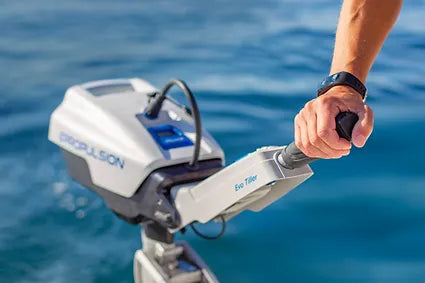The range of an electric boat on a single charge can vary significantly based on several factors. These factors include the battery capacity, the boat's efficiency, speed, conditions, and other variables. Here's a breakdown of the key factors that influence the range of an electric boat motor:
1. Battery Capacity: The larger the battery capacity, the more energy it can store, and consequently, the longer the potential range of the electric boat. Battery capacity is usually measured in kilowatt-hours (kWh). A higher-capacity battery can provide a longer range, assuming all other factors remain constant. Small electric outboards like the ePropulsion Spirit and Torqeedo Travel have batteries that mount right on top of the shaft, as pictured below. Electric outboard users who have range requirements greater than one battery pack can purchase a second battery and swap them out as needed.

2.Boat Efficiency: The efficiency of the boat's hull design, weight, and overall construction impacts how effectively it uses the energy from the battery. A more streamlined and lightweight boat is likely to have better efficiency and, thus, a longer range. Multihulls produce less drag than monohulls and will typically have a longer range than a monohull of the same length if all else is equal. The same hydrofoils that have been taking the wind sports world by storm are being applied to electric boats by companies such as Candela, Navier, and Epoch. Hydrofoils reduce drag by lifting the electric boat's hull fully or partially out of the water.
3. Speed: Higher speeds generally require more power, which reduces the range. Electric boats that are planning require much more power than electric boats that are going slowly, and users will find that they have exponentially more range when going slowly. For instance, our 130 Sport Boston Whaler with Pure Watercraft's 50hp electric outboard had a run time of 30 minutes while doing 17kts on the plane, and a run time of 20 hours at 4kts.
4. Conditions: Just like a gas outboard, an electric outboard will have a shorter range if you're fighting wind, current, or waves. Operating the boat in favorable conditions can improve the range, while adverse conditions might reduce it.
5. Load: The weight of passengers, cargo, and equipment onboard affects the boat's overall efficiency and energy consumption. Heavier loads require more power, leading to a shorter range.

6. Battery Management: Battery management systems and technology can impact the energy efficiency of the boat. Modern systems optimize power usage and extend the range by managing energy flows more effectively. Some electric outboards, such as Pure Watercraft's 50hp, will limit your power output when your electric outboard's battery reaches a low state of charge, typically about 20%.
7. Depth of Discharge: The extent to which the battery is discharged and then recharged, known as the depth of discharge (DoD). Deeper discharges of the battery can reduce its overall efficiency and impact the available range. Limiting the depth of discharge can help maintain better battery performance. We recommend that users avoid running their electric outboard battery below 20% regularly, as doing so will decrease the lifespan of the battery.
8. Charging Habits: The state of charge of the battery at the start of a trip can influence the range. Starting with a full battery ensures maximum available energy. Just like you've checked how much gas is in your tank before leaving the dock, you'll need to check the state of charge of your electric outboard.

As battery technology advances and electric boat systems become more optimized, we can expect to see improvements in range as well. It's recommended to consult the manufacturer's specifications and user guidelines for specific range estimates based on the model, battery capacity, and usage scenario.
When we repower a boat with an electric outboard, and when manufacturers decide on battery capacity for a small electric outboard, about one hour of run time at full speed is typically the goal. This is usually enough for most boaters; one hour at full speed often mean's that you'll have an hour and a half or so on the plane and over 8 hours of run time at slow speeds.
It's important to consider how you use your boat and what range requirements you'll need before switching to an electric outboard. You can get an idea of the capacity required with a basic understanding of the kilowatts and kilowatt hours. Electric outboard power output is typically measured in kilowatts (kW), and battery capacity is typically measured in kilowatt-hours (kWh). If you have a 1kW electric outboard and a battery with 1kWh of capacity, you can expect your electric outboard to run for about an hour at a wide-open throttle. A capacity of 2kWh would give you about two hours of run time at wide-open throttle. That being said, it's important to remember that every boat is different, and the actual run time of your electric boat will depend on the factors listed above.
As mentioned above, the type of electric outboard you purchase will determine the range the electric motor can provide for you on your boating adventures. Included below are the ranges of an electric motor from , Torqeedo, and a few options from Flux Marine:
ePropulsion's Spirit 1.0 Evo Range:
ePropulsion

Torqeedo's 1103 C Range:

Flux Marine Motors' Ranges:

Please don't hesitate to send us an email if you have any questions on electric boat range. Happy boating!

